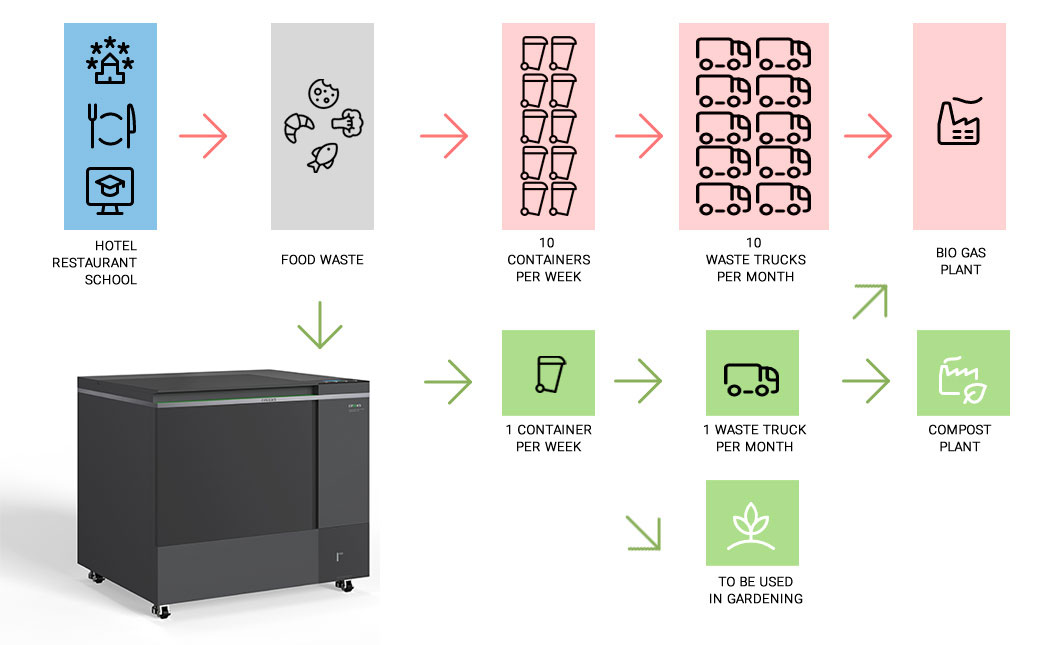Have you ever wondered what happens to your food and yard waste after your local waste management company takes it away? Well, chances are it ends up in an industrial composting facility. These large, commercial operations help to divert waste away from landfills and turn organic matter into nutrient-rich compost. So, what exactly is commercial composting, and how does the process work? Here, we explore the commercial composter so you can learn more about what happens to your waste.
What is Commercial Composting?
Commercial composting is the medium-scale and large-scale processing of organic waste into compost. This helps to prevent biodegradable organic materials from ending up in landfills and allows commercial composting companies to create a valuable product from garden waste and food scraps that would otherwise be thrown away.
It’s based on the same idea as your home compost pile. Essentially, the commercial composting process accelerates the decomposition of organic matter using a variety of techniques. At the end of the process, the compostable materials will have been transformed into nutrient-rich soil that can be used to help grow more fruit and veg.
One of the main benefits of commercial composting is that it helps to divert organic waste, like yard trimmings and leftover food, away from landfills. This is important as untreated green waste will rot down and produce methane gas. Methane is a harmful greenhouse gas that contributes to climate change.
What Is Compostable?
Commercial composter machines can process everything you can at home, as well as a variety of other biodegradable products. For example, commercial composting processes can handle a wide variety of food waste, including bones and grease. Compostable plastics can also be broken down and turned into soil using industrial methods.
Examples of waste that can be processed in a commercial composting facility include:
- Meat
- Avocado and mango pits
- Raw mussel shells
- Fish bones
- Chicken bones
- Dairy products
- Baked goods
- Cardboard covered in food residues
- Bio-solids
- Animal manure
- All food scraps
- Bioplastic

How Does a Commercial Composter Work?
Commercial composter works by creating the optimal conditions for the breakdown of compostable materials. This involves ensuring the temperature, humidity, and airflow are just right and, in some methods, turning the compost regularly to aid micro-organisms and accelerate the process.
Step 1: Loading and Preparation: Organic waste is fed into the machine’s intake system. For most commercial systems, waste is often shredded or ground first to increase its surface area, making it easier and faster for microbes to break down.
Step 2: The Active Composting Phase (Inside the Chamber)
This is where the magic happens. The control system sets the perfect conditions:
- Mixing: The internal augers or paddles rotate, constantly churning the waste mixture.
- Aerating: The system blows air through the mixture, delivering fresh oxygen to the microbes. This is the key to preventing anaerobic decomposition (which causes foul odors).
- Heating: The chamber is heated to and maintained at a specific high temperature. This pasteurizes the compost, killing pathogens, weed seeds, and fly larvae to produce a safe, sanitized end product.
Step 3: Curing and Cooling: After the intense active phase (which can last from 21-24 hours in Creeks’ composting machines), the material is often discharged into a separate curing bin or area. Here, it continues to break down at a slower, cooler rate. This “curing” stage is crucial for stabilizing the compost and completing the process, ensuring it is fully mature and ready for use.
Difference Between Commercial Composter and Home Composter?
One of the main differences between commercial and home composting is time. A commercial composting service will create the ideal conditions for the breakdown of organic matter into a saleable product. This accelerates the process and makes their operations more profitable.
Another key difference is in the variety of waste that can be composted. Commercial composters can handle a much wider range of organic matter, including things like bioplastics and bones, that can’t be processed in domestic outdoor or indoor compost bins.
Conclusion
Commercial composting is an important part of local and national sustainability policies. The more municipal solid waste that’s composted, the less that will end up in landfills, something that’s great news for the environment as well as for businesses interested in achieving zero waste and reducing their carbon footprint. What’s more, as well as keeping waste out of landfill, industrial composting creates a valuable product that can be used to help grow fruit and veg and improve the quality of gardens everywhere.
